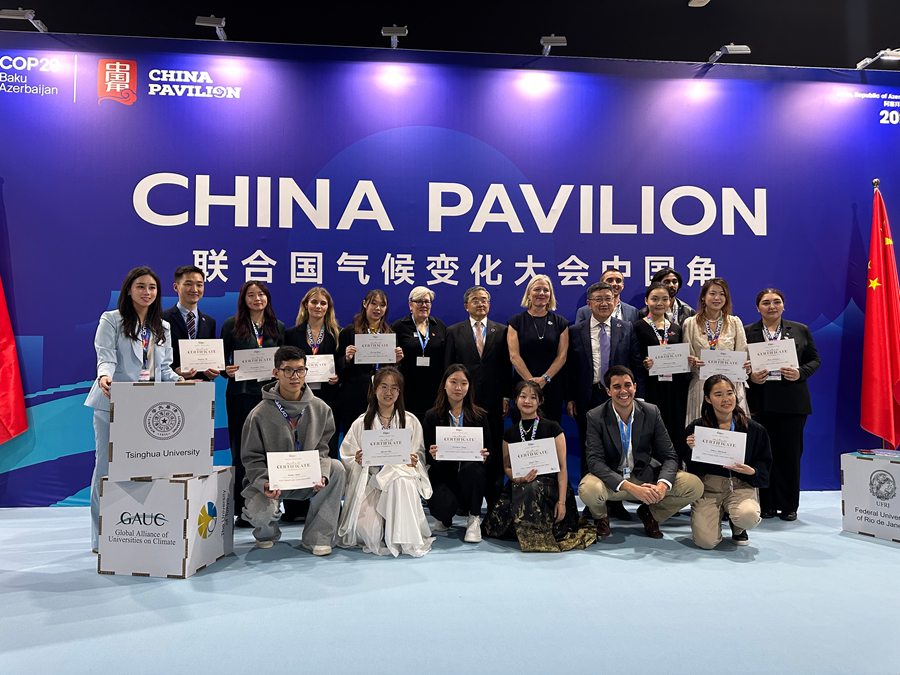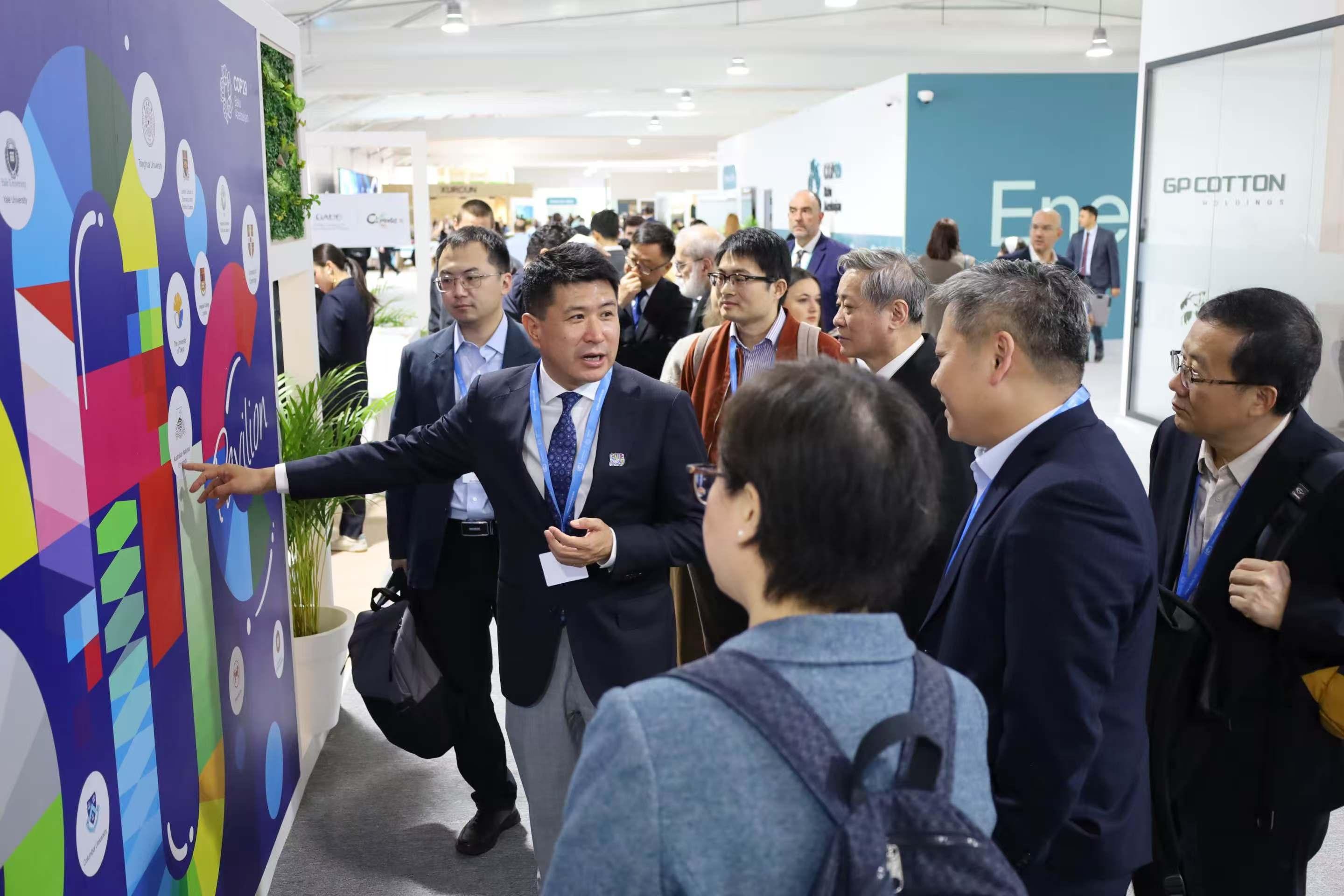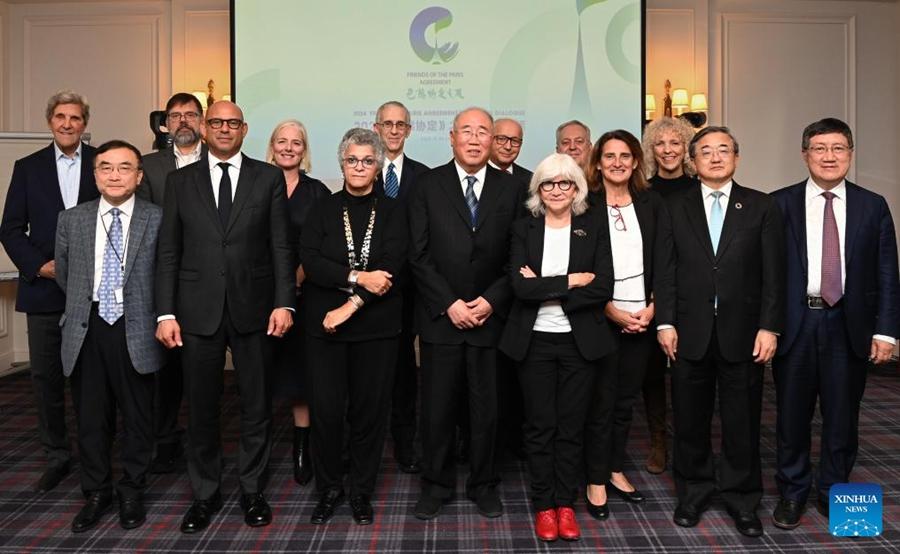Climate response in Tsinghua: Youth and science as catalysts for change
China.org.cn, December 14, 2024 Adjust font size:
Hu Yunche, a sophomore from Tsinghua University, had a deeply moving moment at last month's COP29 in Baku, Azerbaijan, when he witnessed representatives from small island nations gathered at the Blue Zone of the conference venue. They solemnly read aloud the names and ages of those who had lost their lives to extreme weather events caused by climate change. Many of the victims were children.
"I stood there for two minutes, overwhelmed," Hu recalled. "It was a stark reminder of why we should respond to climate change actively and better protect the most vulnerable groups."
This moment of raw emotion solidified Hu's resolve to turn his passion for climate action into meaningful contributions. It had been a mission he had carried since his high school days and continued to champion at Tsinghua.
As president of the Tsinghua University Student Association on Net-Zero Future, Hu, an interdisciplinary engineering major, led efforts to raise campus awareness about sustainability through workshops, seminars, and other events.
"We, as young people, have a responsibility to turn global climate challenges into actionable solutions," he said.
Youth as agents of change
Hu was part of a youth delegation organized by the Global Alliance of Universities on Climate (GAUC), a coalition spearheaded by Tsinghua University. Alongside 16 peers from Tsinghua and representatives from eight other universities across 11 countries, Hu and the other students at the GAUC helped host nearly 40 events at COP29, ranging from urgent topics like energy transitions in the Global South to the decarbonization of healthcare systems, showcasing the critical role of youth in shaping climate solutions.

Youth representatives from Tsinghua University and other universities are given GAUC Youth Ambassadors certificates at the China Pavilion during the COP29 in Baku, Azerbaijan on Nov. 11, 2024. [Photo provided to China.org.cn]
As one of GAUC's founding members, Tsinghua University has consistently emphasized the importance of engaging young people in global climate governance.
"Youth are agents of change," said Zhang Jian, vice secretary-general of GAUC and vice dean of the Institute of Climate Change and Sustainable Development at Tsinghua University. "Their knowledge and actions are crucial for addressing climate change not just in China, but globally."

Zhang Jian, vice secretary-general of GAUC and vice dean of the Institute of Climate Change and Sustainable Development at Tsinghua University, introduces GAUC Pavilion for participants of COP29 in Baku, Azerbaijan on Nov. 14, 2024. [Photo provided to China.org.cn]
Since its inception, GAUC has prioritized connecting students with global decision-makers. At COP29, young delegates engaged directly with negotiators, government officials, and business leaders, amplifying their voices in the international climate discussions.
"We select students every year to attend the UN climate conferences," Zhang added. "There, they can have face-to-face dialogues with officials, negotiators, and other stakeholders, bringing fresh perspectives and advocating for youth-focused solutions."
Beyond these events, Tsinghua emphasizes fostering "climate competency," a concept that goes beyond basic knowledge to include critical thinking, practical skills, and adaptive responses to climate challenges.
"Climate competency helps young people think critically and act rationally on climate issues," Zhang said. "By integrating this into education, we're preparing a generation capable of making informed and impactful decisions."
Shaping global climate governance
Beyond youth engagement, Tsinghua University plays an important role in shaping global climate action through research, dialogue, and other intellectual support.
One of the university's most significant contributions is providing evidence-based recommendations to policymakers. Zhang highlighted Tsinghua's flagship research project, "China's Long-Term Low-Carbon Development Strategies and Pathways: Comprehensive Report," which he described as "the brainchild of over 20 leading domestic institutions that Tsinghua has brought together to analyze strategies for achieving China’s carbon neutrality goal."
"This research directly informed national policies on carbon peaking and neutrality, making it a critical example of how science can drive decision-making," Zhang said.

Participants pose for a group photo during the sixth Friends of the Paris Agreement High-Level Dialogue in Paris, France, on Oct. 28, 2024. [European Climate Foundation/Handout via Xinhua]
In 2019, Tsinghua University and the European Climate Foundation co-launched the Friends of Paris Agreement High-level Dialogue. Held annually, this event has brought together global climate leaders who play pivotal roles in drafting and implementing the Paris Agreement.
"The dialogue provides a platform for in-depth discussions on major climate governance challenges," Zhang noted. "Each year, we produce thematic summaries that are submitted to the UN Secretary-General and COP presidencies to support multilateral progress."
"We aim to serve as a bridge, connecting youth, academia, and policymakers," Zhang said. "Together, we can turn knowledge into action and create meaningful change."
Pioneering scientific efforts for carbon neutrality
As part of its climate change response, China announced that it would strive to peak CO2 emissions before 2030, and achieve carbon neutrality before 2060.
"Achieving carbon neutrality requires more than individual breakthroughs, but a systemic transformation," said Prof. He Kebin, an academician of the Chinese Academy of Engineering and dean of the Institute for Carbon Neutrality at Tsinghua University. "Energy, industry, policy, and society must work together to build a sustainable future."
According to Prof. He, to meet the carbon neutrality goal, China faces challenges including integrating renewable energy into existing grids, managing the supply chain risks of critical minerals, and improving carbon monitoring and accounting systems.
To address these challenges, the integrated research teams in Tsinghua University have already made several breakthroughs.
For instance, Tsinghua researchers have developed pathways to integrate renewable energy into power grids more efficiently. By optimizing "source-grid-load-storage" interactions, they have tackled the variability of solar and wind energy, making large-scale adoption more feasible.
In architecture, the institute has developed a new technology that integrates photovoltaic power generation, energy storage, direct current distribution, and flexible energy consumption systems. This innovation not only increases the installed capacity of Building-Integrated Photovoltaics (BIPV) but also effectively addresses the challenges of managing variable renewable energy, driving the transition to zero-carbon practices in the construction sector.
Another breakthrough lies in real-time carbon monitoring. The institute has developed methods to quantify emissions almost instantly, reducing data lags from years to days. This innovation, paired with the AI-powered "TianGong Initiative," establishes a transparent framework for life cycle assessment, focusing on carbon footprint, empowering industries and policymakers to make data-driven decisions.
He emphasized that achieving carbon neutrality will lead to profound global economic and social transformation, and technological innovation will be the key driving force in achieving this goal.
"We aim to serve as a premier platform for collaboration on carbon neutrality, fostering cross-disciplinary partnerships and technology sharing to advance sustainable solutions and strengthen connections between China and the international community," Prof. He said.

